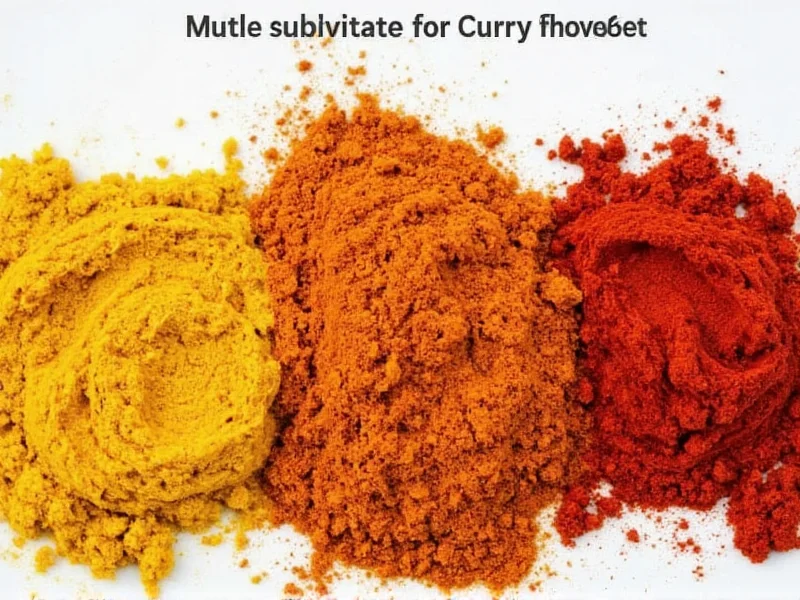Understanding how to properly substitute curry paste for curry powder can save your recipe when you're missing one key ingredient. While both deliver authentic curry flavor, they differ significantly in composition, concentration, and moisture content—factors that directly impact your dish's final texture and taste profile.
Key Differences Between Curry Paste and Curry Powder
Curry powder is a dry spice blend typically containing turmeric, coriander, cumin, fenugreek, and chili powder. It's shelf-stable, concentrated, and adds color without moisture. Curry paste, however, combines these same spices with fresh ingredients like lemongrass, galangal, garlic, shallots, and shrimp paste, suspended in oil or water. This fundamental difference explains why direct 1:1 substitution fails—curry paste introduces unwanted liquid that can ruin your sauce consistency.
Proper Curry Paste to Curry Powder Conversion Ratios
Getting the ratio right prevents your curry from becoming watery or overly intense. The following table shows precise conversions based on flavor concentration testing:
| Curry Powder Amount | Curry Paste Substitute | Liquid Reduction Needed |
|---|---|---|
| 1 teaspoon | 1/2 teaspoon | 1/2 teaspoon |
| 1 tablespoon | 1.5 teaspoons | 1.5 teaspoons |
| 2 tablespoons | 1 tablespoon | 1 tablespoon |
| 1/4 cup | 2 tablespoons | 2 tablespoons |
Flavor Profile Adjustments When Substituting
Curry paste often delivers more complex, fresh flavors compared to powder's earthy profile. When substituting curry paste for curry powder, anticipate these flavor changes:
- Increased brightness from fresh aromatics like lemongrass
- Subtle sweetness from shallots or garlic in the paste
- Potentially stronger heat level (check your paste's ingredients)
- Less vibrant yellow color (turmeric concentration is lower)
Compensate by adding 1/4 teaspoon turmeric when substituting to maintain color, and taste before adding additional salt since many curry pastes contain fish sauce or shrimp paste.
Recipe-Specific Substitution Tips
Successful substitution depends on your specific dish:
Dry Rubs and Marinades
For chicken tikka or lamb marinades, replace curry powder with a 1:1.5 ratio of curry paste and add 1 teaspoon cornstarch per tablespoon of paste to absorb excess moisture. This prevents steaming instead of searing.
Creamy Curries
In coconut milk-based curries like Thai green curry, use a 1:2 substitution ratio (1 part paste to 2 parts powder) without liquid reduction since the extra moisture integrates well with the sauce base.
Dry-Fried Dishes
For stir-fries or dry curries like Chettinad chicken, substitute at a 1:3 ratio and cook the curry paste in oil for 2-3 minutes before adding other ingredients to evaporate excess moisture.
When Substitution Won't Work
Avoid substituting curry paste for powder in these situations:
- Baked goods like curry chicken pie crusts (moisture ruins texture)
- Dry spice blends for rubs where liquid causes burning
- Recipes specifically designed for powder's earthy profile like British-style curry sauces
- When using very fresh, wet curry pastes with high vegetable content
Storage Considerations After Substitution
Curry paste substitutions affect shelf life. Dishes made with paste substitutions typically keep for 3-4 days refrigerated versus 5-7 days with powder, due to the higher moisture content promoting bacterial growth. Freeze curry paste-substituted dishes within 24 hours for best results.
Best Curry Paste Varieties for Substitution
Not all curry pastes work equally well as powder substitutes. For closest results to standard curry powder:
- Use Madras curry paste for general substitutions (balanced heat)
- Choose red curry paste for richer, deeper flavor profiles
- Avoid green curry paste in powder substitutions (too herbal)
- Dry out wet pastes by cooking in oil for 3 minutes before use
Testing Your Substitution
Always test your curry after substitution. Simmer for 5 minutes, then taste and adjust:
- Too watery? Simmer uncovered for 3-5 minutes
- Flavor too mild? Add 1/8 teaspoon curry powder (not more paste)
- Overpowering? Balance with 1 teaspoon coconut milk or yogurt
- Color too pale? Stir in 1/4 teaspoon turmeric
Practical Example: Chicken Curry Recipe Adjustment
Original recipe calls for 2 tablespoons curry powder. To substitute:
- Use 1 tablespoon red curry paste instead of 2 tablespoons powder
- Reduce coconut milk by 1 tablespoon
- Add 1/2 teaspoon turmeric for color
- Sauté paste in oil for 2 minutes before adding chicken
- Simmer 5 minutes longer than recipe states to evaporate excess moisture











 浙公网安备
33010002000092号
浙公网安备
33010002000092号 浙B2-20120091-4
浙B2-20120091-4